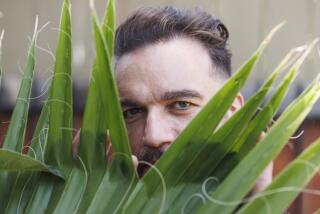Morgan Evans, 92; Directed Landscaping at Disney Parks
Morgan “Bill” Evans, who guided the landscape design of Disney’s theme parks for half a century, from the planning of Disneyland to consulting in the planning for Hong Kong Disneyland, expected to open three years from now, has died. He was 92.
Evans, of Malibu, died Saturday at St. John’s Hospital in Santa Monica. The cause was not reported.
Although he officially retired from Disney in 1975, he continued to work as a design and landscaping consultant until just weeks ago, Disney officials said.
Throughout his career, Evans imported vegetation from around the world to create accurate fictional settings that amplify the storylines of Disney’s various attractions--from the giant bamboo, ficus and towering palms of the Jungle Cruise in the Anaheim park to the African plants that he brought to Disney’s Animal Kingdom in Orlando, Fla.
Evans’ knowledge of plants was legendary, colleagues said, and his skill at matching plants to a story can be seen everywhere in the parks, from the forest on the Tom Sawyer Adventure in Anaheim to a planned jungle in the Tokyo park, which has to use heaters to preserve the plants in winter.
And he cared about even the most minor details. “He could walk through the park and tell you where every specimen, every tree and plant came from,” said Marty Sklar, vice chairman of Disney Imagineering, who oversees the creative team for the theme parks and worked with Evans since Disneyland’s opening.
“He was one of Walt’s favorites,” Sklar told The Times.
Evans and his brother Jack came to work for the Disney company after designing the landscaping for Walt Disney’s Holmby Hills home, in particular the Carolwood Pacific Railroad in his backyard.
A young Walt Disney had met the Evans family years earlier, when he came to buy some roses from their nursery for his three-bedroom house in the San Fernando Valley, said Paul Comstock, director of landscape design at Disney, who was a protege of Evans.
An expert in his field, Evans was also practical.
At a dinner in 1965 celebrating Disneyland’s 10th anniversary, “Walt recalled how when they were getting close to opening the park, they were running out of money,” Sklar said, “so he told Bill to use smaller plants and to put Latin names on all of them. Walt said, ‘Bill never ran out of Latin names; he even put them on the weeds.’ ”
A third-generation horticulturalist, Evans was born in Santa Monica on June 30, 1910, to a wealthy family that had helped develop Lido Island in what is now Newport Beach in the early part of the century.
When the family was hit hard by the stock market crash in 1929, Evans left Stanford University, where he was studying engineering, to help his father, Hugh, and brother Jack turn a backyard garden of exotic plants into the prospering Evans & Reeves nursery in West Los Angeles.
Although the nursery closed in the 1960s, Hugh Evans is remembered today for introducing exotic plants to Southern California.
Among his many legacies are the rows of flowering coral trees that line San Vicente Boulevard in Brentwood, all of which originated with cuttings he brought from South Africa.
When he started working in Anaheim in the early 1950s, Bill Evans used his instinct for preserving native plants to figure out which of the site’s trees could be saved for use in the park.
The 1950s were also a time when large tracts of nearby land were being razed to build the region’s interstate freeway system, and Evans regularly stopped highway workers from bulldozing trees.
“He perfected a way of moving trees--drilling a hole in the trunk and lifting it with a steel pole,” Sklar said.
One such moment came when Pershing Square in downtown Los Angeles was being razed for a parking structure. “Bill got there at 4 in the morning and saved those trees,” Sklar said. Many of these, and other rescued vegetation, still grace the theme park. They made it seem more established when it opened, and today look as if they’ve always been there.
On the Mark Twain Riverboat Ride at Disneyland, a lush forest was built to replicate all of the native species that line the rivers of North America. The trees include locally grown conifers, London plane trees and their cousin, the California sycamore, as well as the European birch, all widely available in Southern California when Disneyland was built, Comstock said. “He would select trees that would replicate the storytelling environment, and that’s what he taught us to do.”
The sculpted plants of Dumbo and other characters also are an Evans touch. “Walt had been to Europe and seen some topiary” that was probably a century old, Evans recalled in an interview in The Times in 1989. “I told him, ‘Walt, the stuff you see will probably take us 20 years.’ ”
Undaunted, Evans crafted a facsimile in just two years by avoiding the usual wire frames and bending full-grown plants to fit the shapes. “We started off with a crocodile and the hippos from ‘Fantasia,’ ” Evans said.
In his long and diverse career, Evans was also a writer for Sunset magazine, a trustee for the Los Angeles County Arboretum and a fellow of the American Society of Landscape Architects.
He is survived by his wife, Natalie; son Pete Evans and daughter Barrie Evans-Blattau; stepdaughters Michele Novak and Stephene Scott; grandchildren Caitlin, Jackson and Morgan Lili; and great-granddaughter Isabella.
A “Bon Voyage Celebration” in remembrance of Bill Evans is scheduled for 5 p.m. Sept. 25 at Descanso Gardens, 1418 Descanso Drive, La Canada-Flintridge.
In lieu of flowers, the family asks that contributions go to the charity of the donor’s choice or to the Descanso Garden Guild, Development Department, for the Bill Evans Horticultural Collection Fund.


